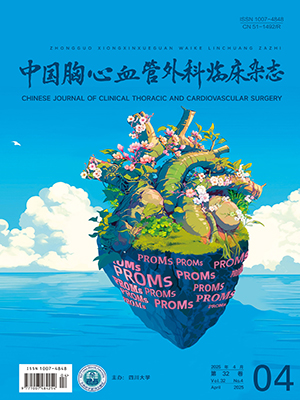| 1. |
Izumi C, Eishi K, Ashihara K, et al. JCS/JSCS/JATS/JSVS 2020 guidelines on the management of valvular heart disease. Circ J, 2020, 84(11): 2037-2119.
|
| 2. |
Abe Y, Takahashi Y, Shibata T. A new disease entity: Atrial functional mitral regurgitation. J Cardiol, 2021, 77(6): 565-569.
|
| 3. |
Vajapey R, Kwon D. Guide to functional mitral regurgitation: A contemporary review. Cardiovasc Diagn Ther, 2021, 11(3): 781-792.
|
| 4. |
Ailawadi G, Lim DS, Mack MJ, et al. One-year outcomes after MitraClip for functional mitral regurgitation. Circulation, 2019, 139(1): 37-47.
|
| 5. |
叶蕴青, 吴永健. 功能性二尖瓣反流的治疗进展. 中国心血管杂志, 2015, 20(6): 480-482.Ye YQ, Wu YJ. Progress in the treatment of functional mitral regurgitation. Chin J Cardiovasc Sci, 2019, 139(1): 37-47.
|
| 6. |
Wagner CM, Brescia AA, Watt TMF, et al. Surgical strategy and outcomes for atrial functional mitral regurgitation: All functional mitral regurgitation is not the same! J Thorac Cardiovasc Surg, 2022, 167(2): 647-655.
|
| 7. |
Watanabe N, Maltais S, Nishino S, et al. Functional mitral regurgitation: Imaging insights, clinical outcomes and surgical principles. Prog Cardiovasc Dis, 2017, 60(3): 351-360.
|
| 8. |
潘文志, 周达新, 葛均波. 二尖瓣反流机制的新认识及其应用. 中国医学前沿杂志 (电子版), 2017, 9(10): 43-46.Pan WZ, Zhou DX, Ge JP. New understanding of mitral regurgitation mechanism and its application. Chin Med Front J (Electronic Edition), 2017, 9(10): 43-46.
|
| 9. |
Di Mauro M, Cargoni M, Liberi R, et al. Mitral valve repair or replacement. How long is this feud to last? J Card Surg, 2022, 37(6): 1599-1601.
|
| 10. |
Daneshmand MA, Milano CA, Rankin JS, et al. Mitral valve repair for degenerative disease: A 20-year experience. Ann Thorac Surg, 2009, 88(6): 1828-1837.
|
| 11. |
Lazam S, Vanoverschelde JL, Tribouilloy C, et al. Twenty-year outcome after mitral repair versus replacement for severe degenerative mitral regurgitation: Analysis of a large, prospective, multicenter, international registry. Circulation, 2017, 135(5): 410-422.
|
| 12. |
Can T, Kirov H, Caldonazo T, et al. Surgical mitral valve repair technique considerations based on the available evidence. Turk Gogus Kalp Damar Cerrahisi Derg, 2022, 30(2): 302-316.
|
| 13. |
Campos-Arjona R, Rodríguez-Capitán J, Martínez-Carmona JD, et al. Prognosis for mitral valve repair surgery in functional mitral regurgitation. Ann Thorac Cardiovasc Surg, 2022, 28(5): 342-348.
|
| 14. |
余森, 葛树明, 丁诗力, 等. 二尖瓣反流行成形术或置换术后左心结构与功能早中期对比研究. 中华胸心血管外科杂志, 2019, 35(10): 583-587.Yu S, Ge SM, Ding SL, et al. A comparative study of left heart structure and function in the early and middle stages after reverse mitral valve plasty or replacement. Chin J Thorac Cardiovasc Surg, 2019, 35(10): 583-587.
|
| 15. |
Gaasch WH, Meyer TE. Secondary mitral regurgitation (part 2): Deliberations on mitral surgery and transcatheter repair. Heart, 2018, 104(8): 639-643.
|
| 16. |
Shah N, Madhavan MV, Gray WA, et al. Prediction of death or HF hospitalization in patients with severe FMR: The COAPT risk score. JACC Cardiovasc Interv, 2022, 15(19): 1893-1905.
|
| 17. |
Petrus AHJ, Dekkers OM, Tops LF, et al. Impact of recurrent mitral regurgitation after mitral valve repair for functional mitral regurgitation: Long-term analysis of competing outcomes. Eur Heart J, 2019, 40(27): 2206-2214.
|
| 18. |
Kawamoto N, Fukushima S, Kainuma S, et al. Mitral valve surgery for atrial functional mitral regurgitation: Predicting recurrent mitral regurgitation and mid-term outcome. Gen Thorac Cardiovasc Surg, 2022, 70(9): 761-769.
|
| 19. |
Imielski B, Malaisrie SC, Pham DT, et al. The impact of intraoperative residual mild regurgitation after repair of degenerative mitral regurgitation. J Thorac Cardiovasc Surg, 2021, 161(4): 1215-1224.
|




